You’re at a thrift shop and see a vintage Armani suit you love, but the shoulders are too wide. Should you buy it? In situations like these, the difference between getting a steal and wasting your money depends on whether your tailor can complete the required alterations to make the item fit you well.
How Many Sizes Larger or Smaller Can You Go?
The first rule of alterations is that taking away or reducing the amount of fabric is doable, but you can’t make something bigger, at least not by much. Exactly how much depends on what allowances of extra material were under the seams or hems of the garments. Tailored pants and jackets that were originally expensive or well made, especially bespoke, will usually contain more allowances, future-proofing for the changing size of the wearer over time. Ready-to-wear or less expensive items usually have little or no extra material to let out as a means of keeping costs down. Therefore, you’ll have better chances for a successful alteration if your find is a bit too big rather than too small for you.
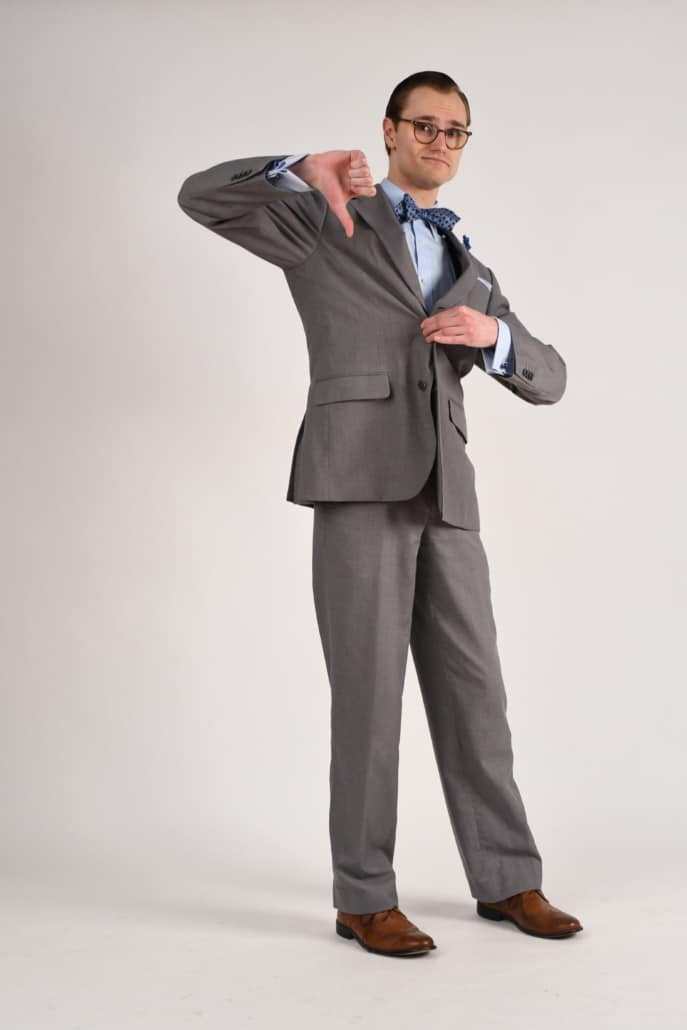
A suit that is too large and baggy may be beyond a tailor’s help
With that said, there are also limits in making things smaller. A suit jacket is quite complex in construction and can’t simply be shrunken down multiple sizes, because the proportions will be altered and the elaborate structure (lining, canvas, padding, pockets, etc.) will have to be reconstructed to the point that it would be more cost-effective to buy a whole new jacket. However, it’s not major surgery to cinch (“take in”) the sides, waist, chest and arms (more on these alterations later). The rule of thumb is that you can go down two sizes at a maximum, but a suit jacket or blazer only one size too large is a safer option. The problem is always that jackets that are too large can also be too large in the shoulders, which is a more challenging thing to alter.
Trousers are a little more forgiving, especially if you want to go with a high-waisted look. While legs can be made narrower and waistbands taken in, the rise of a pair of pants–the distance between the waistband and crotch–is more difficult to change. But, if a high rise is your style, you can transform a too-large pair of mid- or even low-rise pants into high rise by altering the parts that can be tailored and leaving the rise alone. In this way, a potential deal-breaker can actually be something desirable.
Altering the Shoulders of a Suit Jacket
1. Changing the Width of Shoulders – NO
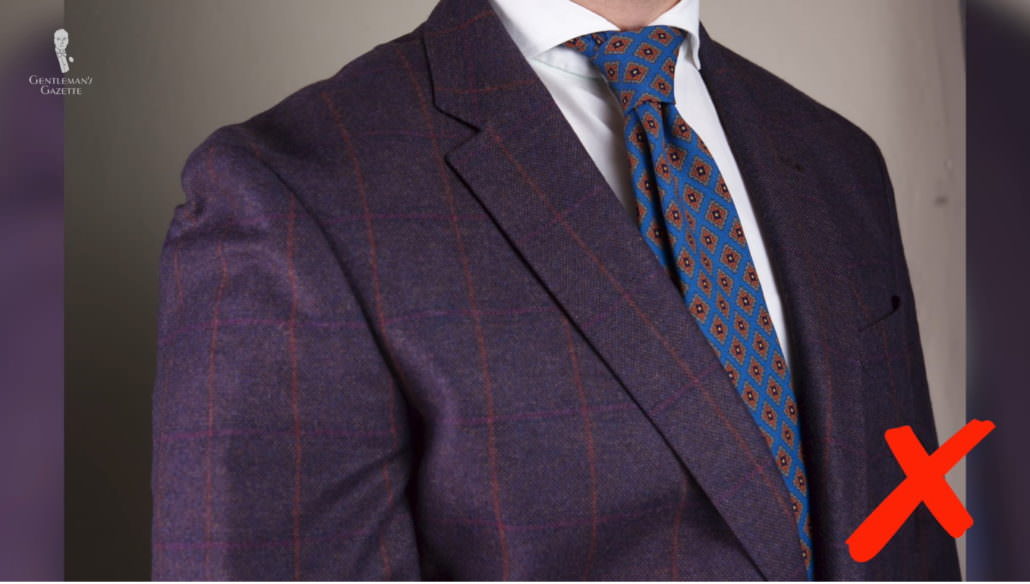
A poorly fitting jacket shoulder (Tie: Wool Challis Tie in Turquoise with Gray, Orange, Navy and Yellow Pattern – Fort Belvedere)
With this ground rule established, let’s look at the parts of a tailored outfit from top to bottom in terms of what can be altered and what cannot, starting with the shoulders of a suit jacket (or sport coat, or blazer). Of course, as the first thing we consider, shoulders are an exception to the rule; making shoulders either bigger or smaller are both not recommended as alterations. The structure of a jacket shoulder is complex enough that reshaping them involves major surgery.
2. Changing the Pad Level of Shoulders – MAYBE
If your body doesn’t suit a padded shoulder, you can remove shoulder pads with the goal of a natural Neapolitan shoulder or add them in an attempt to make a Neapolitan style into a more British jacket. In both cases, the structure of the shoulder will change (and along with it, the appearance of the jacket), but the result will never be the same as one in the original style. It’s sort of like taking a cheap car, adding a rear spoiler and a decorative hood scoop, and calling the result a race car. The result will never be authentic or even look as good as buying a new jacket with the sort of shoulder you wanted in the first place.
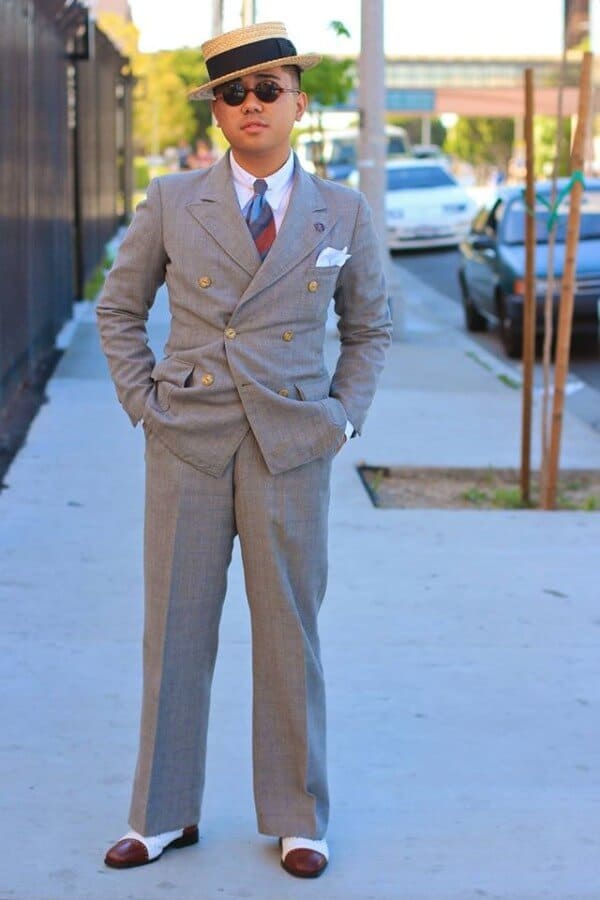
Ethan wearing his beloved spectators and a DB suit with faint mini windowpane paired with a boater hat
Ethan Wong recently experimented by having a padded shoulder turned into a natural one; he made use of a highly skilled tailor to do more than just change the padding. Ethan also didn’t try to pass the jacket off as Italian tailoring; his goal was just to improve the overall look and fit of the garment. If you go this route, it’s important that the tailor is experienced and the jacket one you’re willing to have significantly altered.
Changing the Collar – MAYBE
An alteration that is rarely thought about is altering the collar of a suit jacket. This is not an area that jumps to mind as having an impact on the look or even fit of a suit, but a collar that is overly large for your neck will result in the dreaded “collar gap.” If this is something that affects your suits, you may be tempted to do something about it by having the collar removed and re-cut. It can be done, but this is another case where it’s better to simply buy a jacket that doesn’t gap, as the repair can be costly and collar gap can have other causes, like having one shoulder wider or lower than another or a particular posture.
Altering Sleeves on a Jacket
1. Narrowing, Lengthening, and Shortening Sleeves – YES
Sleeves may be the easiest part of a jacket to change–after all, they’re essentially two tubes with little complex structure to them. Narrowing ones that are too large around the arms is an easy alteration. Making sleeves slightly longer or shorter, say by a 1/2″ or so, is also a fairly routine procedure. But longer lengthening, even if there’s enough material, puts the buttons too far away from the edge of the sleeve, while shortening too much puts the first button too close to the end of the sleeve, both of which look strange.
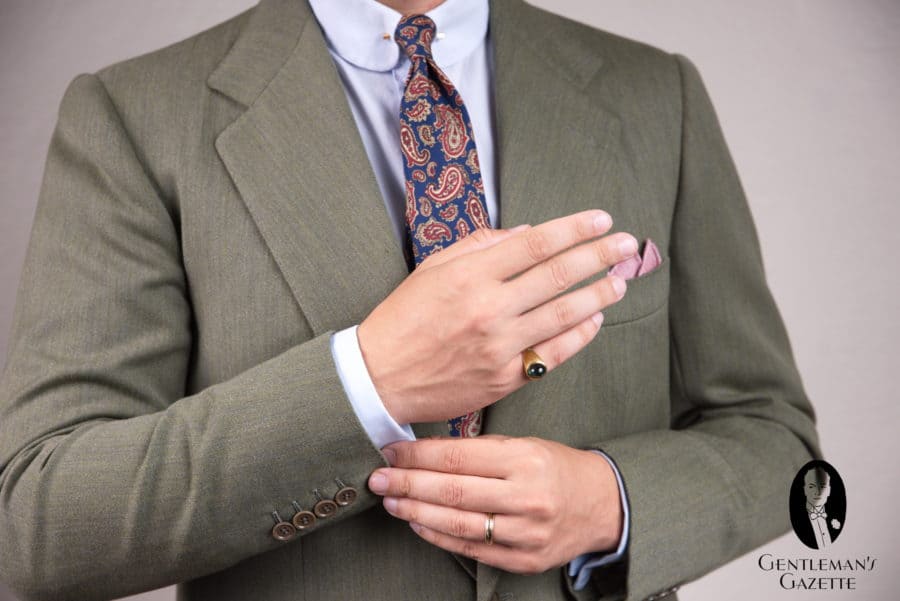
The amount of cuff Sven Raphael Schneider likes to show. Note the correct distance from the last button to the end of the jacket sleeve. (Tie: Madder Silk Tie in Blue with Buff and Red Paisley – Fort Belvedere)
If your sleeve buttons are non-functioning, a tailor can move the top or bottom button (and pick out the decorative stitching) to balance out larger changes of sleeve length. However, if you have working buttons this is a more difficult alteration because it will not be possible to sew up the former buttonholes cleanly; these are really tears in the fabric that can only be closed with the services of a reweaver–a specialist who can reweave the cloth–who are rare to find.
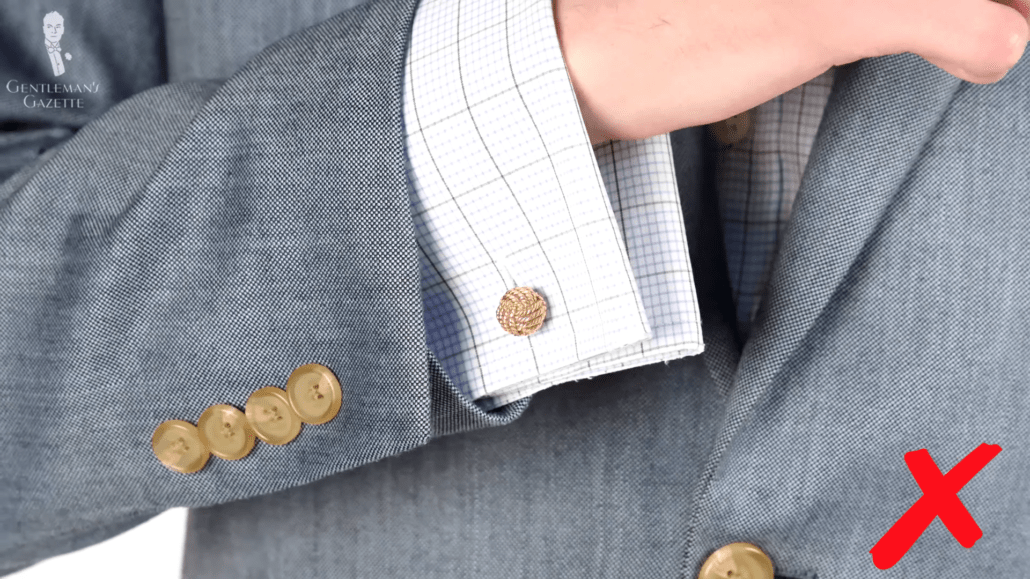
As the sleeve buttons on this jacket are non-functioning, lengthening it would be possible. (Cufflinks: Monkey’s Fist Knot Cufflinks – 925 Sterling Silver Rose Gold Plated – Fort Belvedere)
This is one instance where a higher-end tailoring detail is actually detrimental to alterations, so if you pick up a jacket with functioning sleeve buttons, make sure the sleeves don’t need extensive lengthening or shortening. In fact, even cleaning up the stitching on non-functional sleeves can be imperfect, so exercise caution. An alternative is to have a skilled tailor shorten the sleeve by removing it and reducing it at the shoulder rather than at the bottom. Lengthening can also be done at the shoulder depending on whether there is an extra fabric available. Both are more expensive.
2. Putting on Buttons – YES
Speaking of sleeve buttons, when you buy a higher-quality tailored jacket, there will usually not be any buttons on the sleeve, which lets you determine the proper length before you put them on. Obviously, then, this is a necessary and supposedly routine alteration, but it can be tricky getting it done right. Most smaller local tailors or seamstress shops don’t have the ability or equipment to do it and will complain that the job is undesirable for them. Even the usual tailor the author (Dr. Christopher Lee) uses in a Midwestern city can only do it by hand to the tune of $150. Dr. Lee ends up having this done in New York (for $10 a button) at Sam Wazin who is also used by The Armoury. This goes to show that, depending on where you live, a routine tailoring job can be not so routine after all.
3. Fixing Shoulder Divots – MAYBE
One sleeve-related alteration that is potentially challenging and expensive is fixing shoulder divots or dimples. These can be created, especially on heavier-weight fabrics like flannels, if:
1) The sleeve is connected to the armhole of the jacket in a way that doesn’t match the way you naturally hold your arms in the resting position, or
2) The armhole is considerably smaller than the sleeve opening that attaches to it.
A tailor can try to fix these issues (around $90 per sleeve by the author’s estimate) by removing the sleeve and rotating it to match your posture or by reducing the size of the sleeve. This is a doable alteration, but results are not 100% guaranteed, and, again, the cost is high.
Alterations to the Body of a Jacket
1. Changing the Button Profile – NO
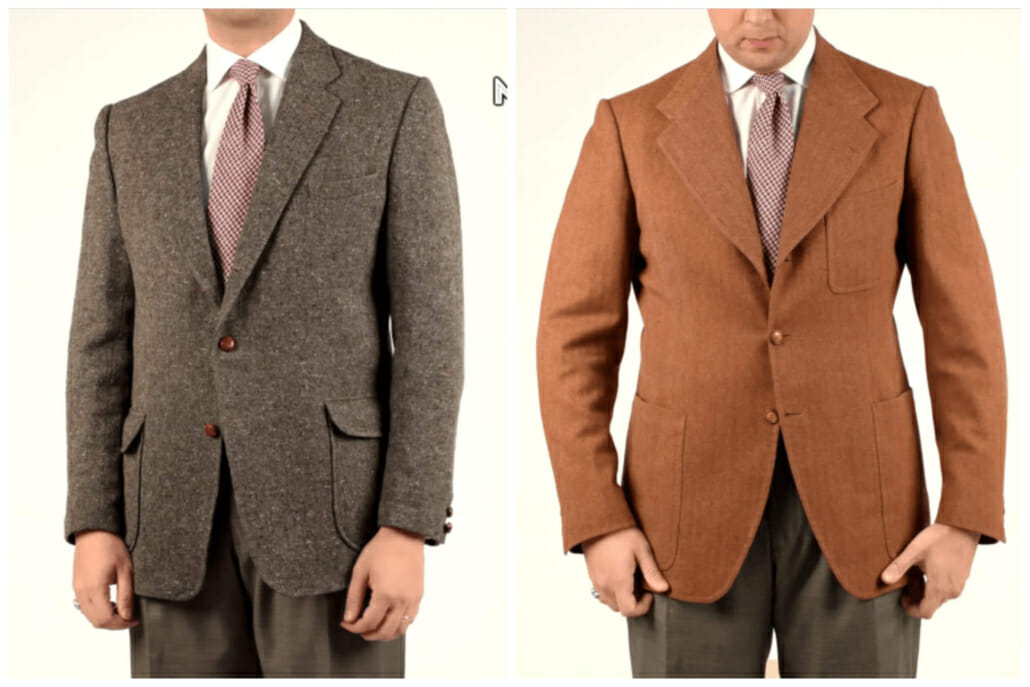
A three-roll-two button jacket at left vs. a hard three-button at right. Note the different lapel shapes (Tie: Houndstooth Bourette Silk Tie in Burgundy Red Cream – Fort Belvedere)
As noted above, taking in aspects of the body of a jacket are fairly simple, and letting out what is available at the seams is as well. Other alterations to the body are not recommended. One that is commonly asked about is related to the number of buttons. Subtracting buttons, like turning a three-button suit into a two, is not doable because it would require the closure of the additional buttonhole, which cannot be done cleanly. Moreover, the placement of the buttons is different. The same is true for plans to turn a hard three-button or even a two into a three-roll-two buttoning scheme where the top button is rolled under the lapel.
2. Changing the Lapels – MOSTLY NO
If you have a single-breasted jacket you love, but you dislike its peak lapels, it might be possible to turn them into notch lapels if there is sufficient fabric. Peak lapels are usually larger and wider, so the possibility is high unless you are beginning with an anemic peak lapel as shown above. The opposite operation can’t be done, however, because a notch lapel will be smaller, to begin with, and lack the additional “point.” If you want your new notch lapel to be narrower, the underlying canvas will likely have to be cut and reshaped, but if the width stays the same, less work is required.
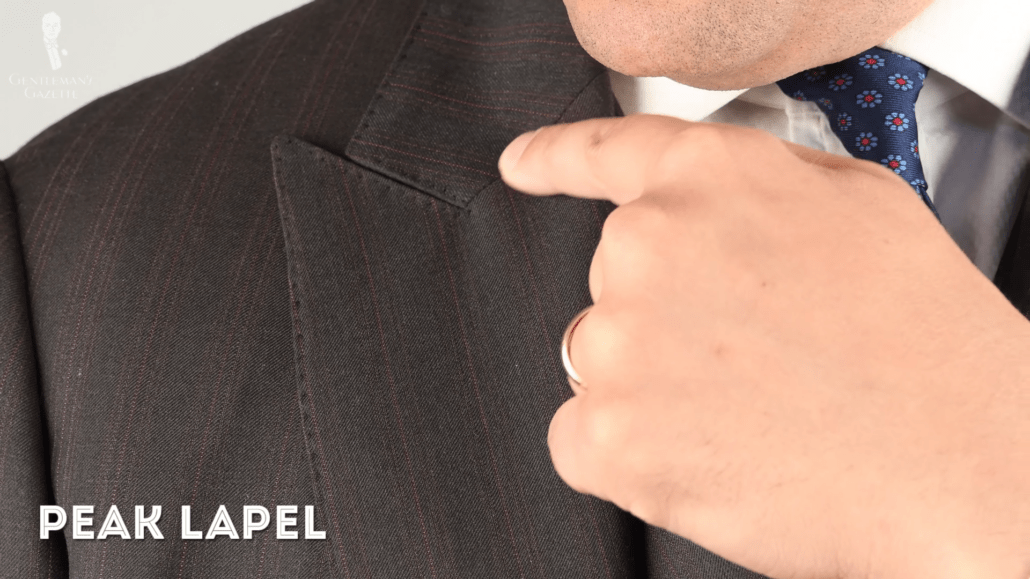
Peak lapels
You will almost always face issues with the lapel buttonhole because it’s supposed to run parallel to the top edge of the lapel, which points upward in a peak lapel and downward in a notch; the buttonhole will also be in a different location. If this doesn’t bother you, then it’s something you can explore. However, if you’re going this far to perfect a jacket, you will almost certainly find the imperfect buttonhole angle irritating. With this in mind, the only real alteration recommended with a lapel is adding a hidden boutonniere loop to the underside. This will keep your boutonniere flower “stem” properly aligned. Of course, you can also do this yourself at home.
3. Reshaping the Quarters of a Jacket – NO
The quarters represent the lower front flaps of your suit jacket panels, the area below the bottom button, also called the skirts of the jacket. These can either be closed, meaning the flaps lie nearly straight down when buttoned, or open, meaning the panels are curved and cut away or flared out when buttoned. The former look is more conservative and business-like, but if you want some Neapolitan bravado, you may think about having your quarters opened. Simply put, however, cutting away and reshaping the panels will affect the button position and cannot be done effectively.
4. Shortening the Jacket – MAYBE
While lengthening a jacket is impossible because there simply isn’t enough fabric to exploit, shortening from the bottom is possible provided you are only reducing the length by a small amount. If you take off too much length, the pockets and bottom button will be dangerously close to the bottom, which will look even worse than having buttons that are too close to the sleeve edge.
5. Changing the Vent Openings on the Back – MAYBE
These days, the majority of quality suits will be sold with a double vent opening at the back. However, if you own a cheaper single-vented suit or an Italian-style suit with no vent at all, you may have toyed with the possibility of converting the vents. Realistically, you can’t increase the number of vents, because you need to have enough fabric to cover the seam and lining that will be exposed on the edges of the new flaps. On the other hand, closing the vents is possible, since there are ordinarily seams on the back of jackets anyway that can simply be continued all the way to the bottom.
Alterations to a Suit’s Trousers
Hems, Cuffs and Leg Length on Pants – YES
Following the general principle we began with, pant legs can be made shorter, but they can only be lengthened to the extent of whatever hem material is left at the bottom. Quality dress pants are sold unhemmed with a lot of extra fabric at the bottom, but a tailor will not leave more than a couple of inches under the hem when they’re finished. This extra material can also be turned into cuffs if you desire, so this is another easy alteration, as is the opposite–removing cuffs.
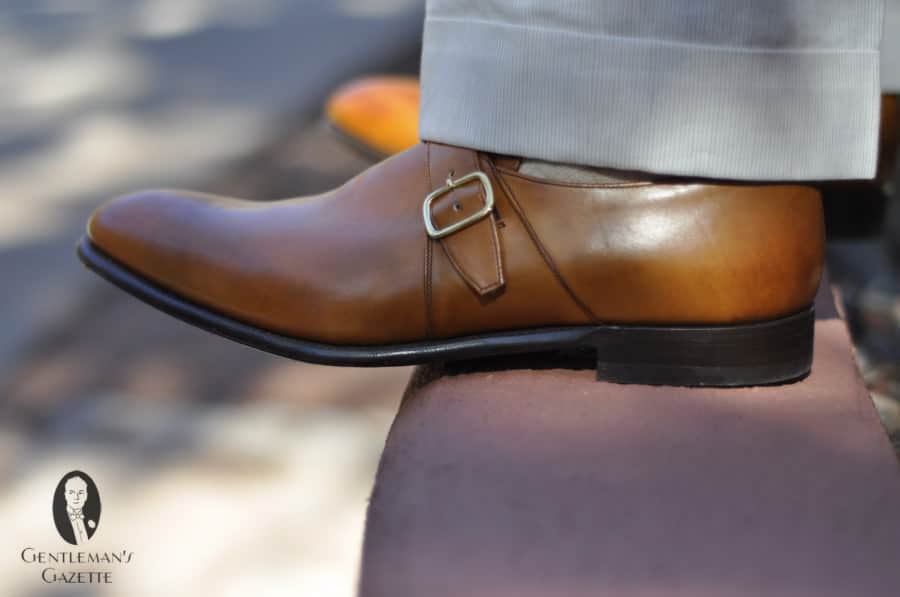
Tan Monk Strap Shoes with beige cuffed pants
Tapering and Decreasing Leg Width – YES
While legs cannot be made larger, they can easily be tapered, especially from the knee to the bottom if the leg opening is too wide at the bottom (an 8″ opening tends to look best for most). In fact, tapering is one of the easiest alterations.

Ethan Wong’s strategy for attaining a higher rise often involves buying a size up and tapering the legs
Adding to and Subtracting from the Waist – YES
Because it’s commonly understood that waistlines fluctuate in size (we’ve all been there, right?), pants manufacturers are usually pretty generous in providing allowances of material to enlarge the waistband and upper part of the seat from the waist toward your rear end. The exact amount varies by the size, but at least 2-3″ is found at the center rear seam. The opposite can be done as well, also at the rear, to around the same limit. Anything more than 2-3″ will affect the balance of the trousers as the rear pockets get close together. All changes to the waistband should also require some alteration to part of the seat.
From these examples, it’s clear that pants are simpler in construction than a jacket, facilitating more ready changes, though, as noted at the start of the article, the rise is the most difficult to change as it requires removing the waistband and replacing the zipper as well.
Conclusion
There are many different alterations that are possible when you examine the components of a suit. Understanding the anatomy of a pair of pants or a tailored jacket will also make you aware of what can and cannot be done. Study the garments you own–look at the seams for allowances, check for previous work, and get a sense of its structure. Then weigh the advice above against your love for the item. You can then decide whether it’s something you are willing to invest in or if you would just prefer to buy something new (or vintage!).
Have you tried any of these alterations with success or failure? Share your stories in the Comments section.
Source: gentlemansgazette.com
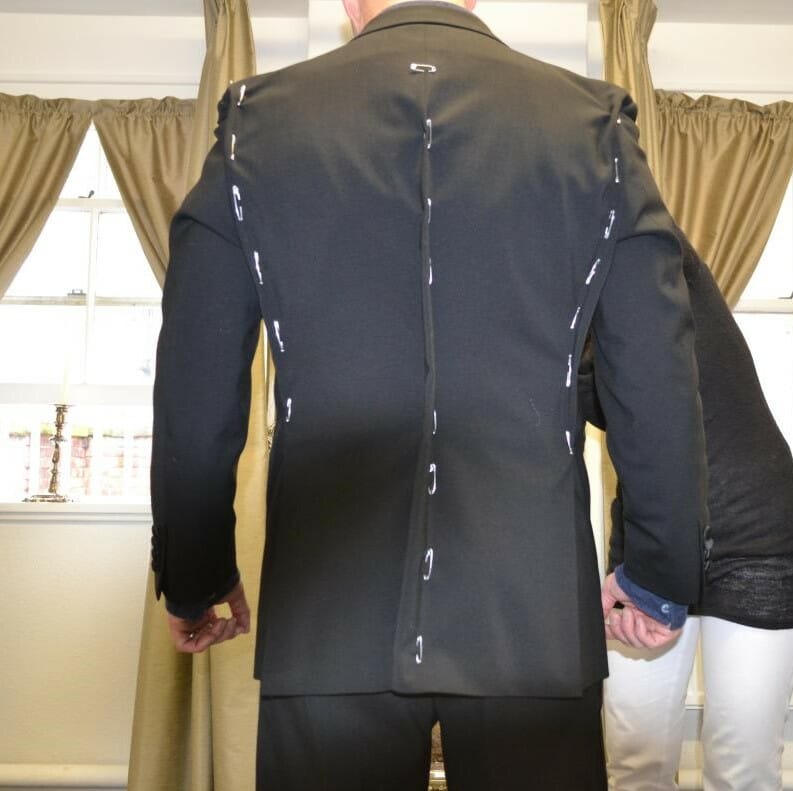
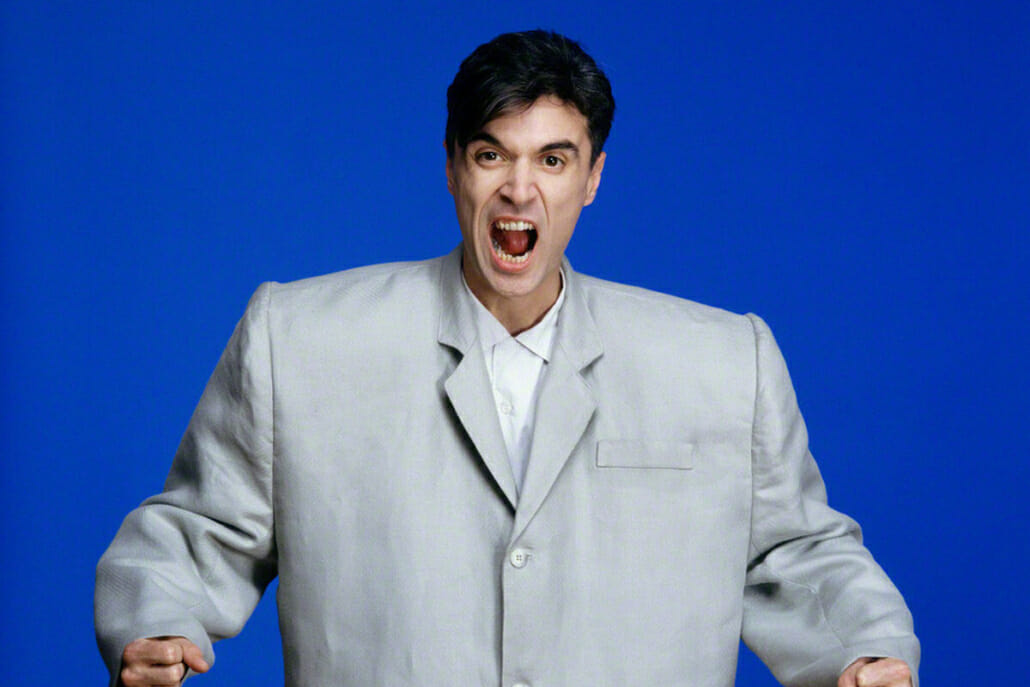


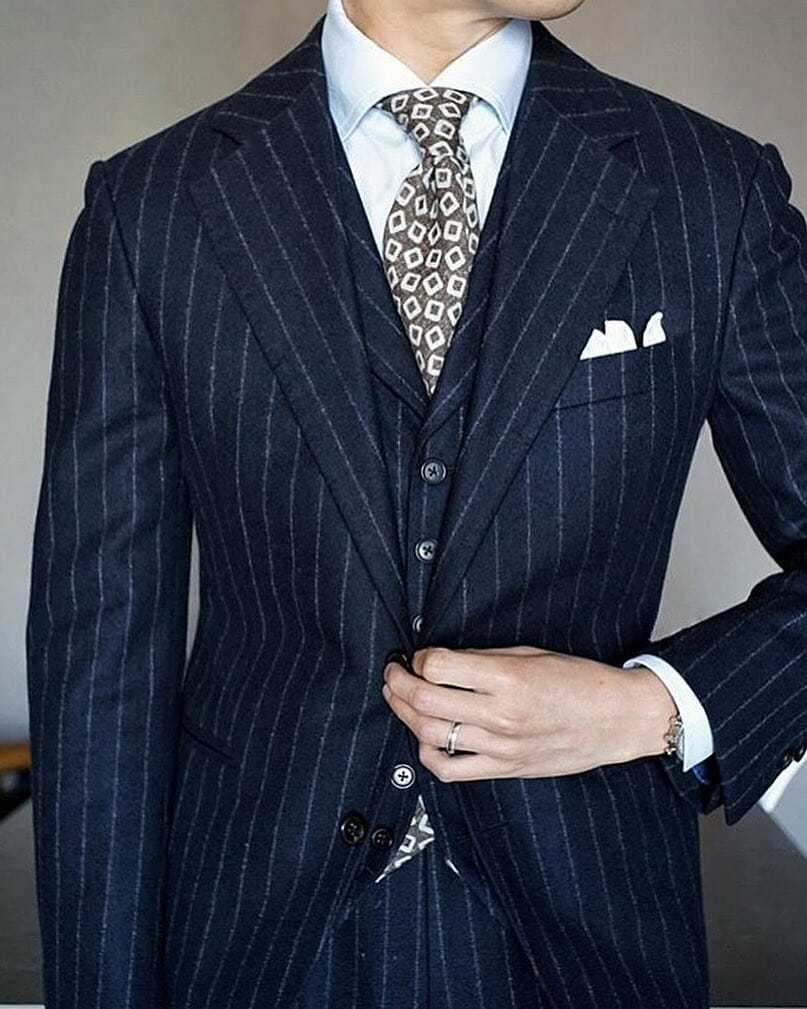

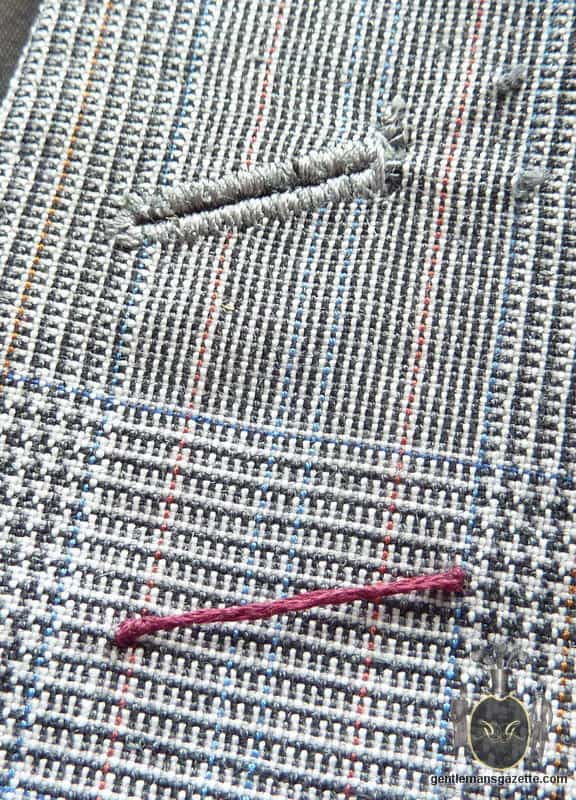

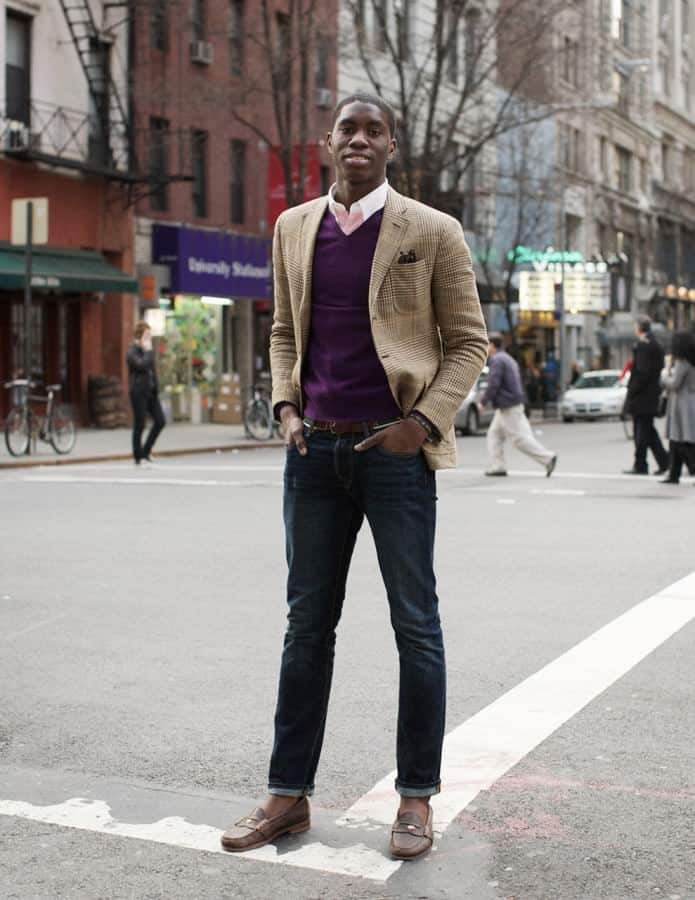
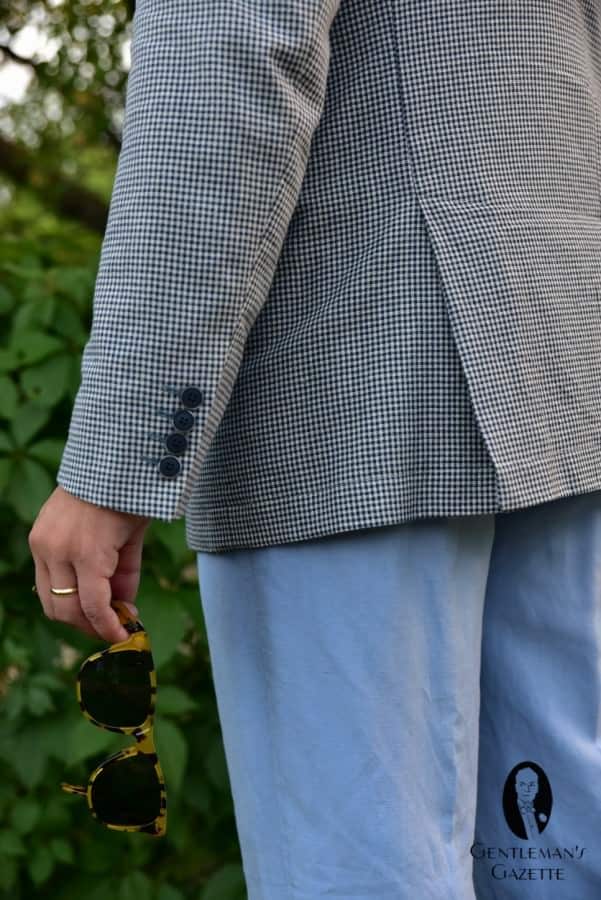
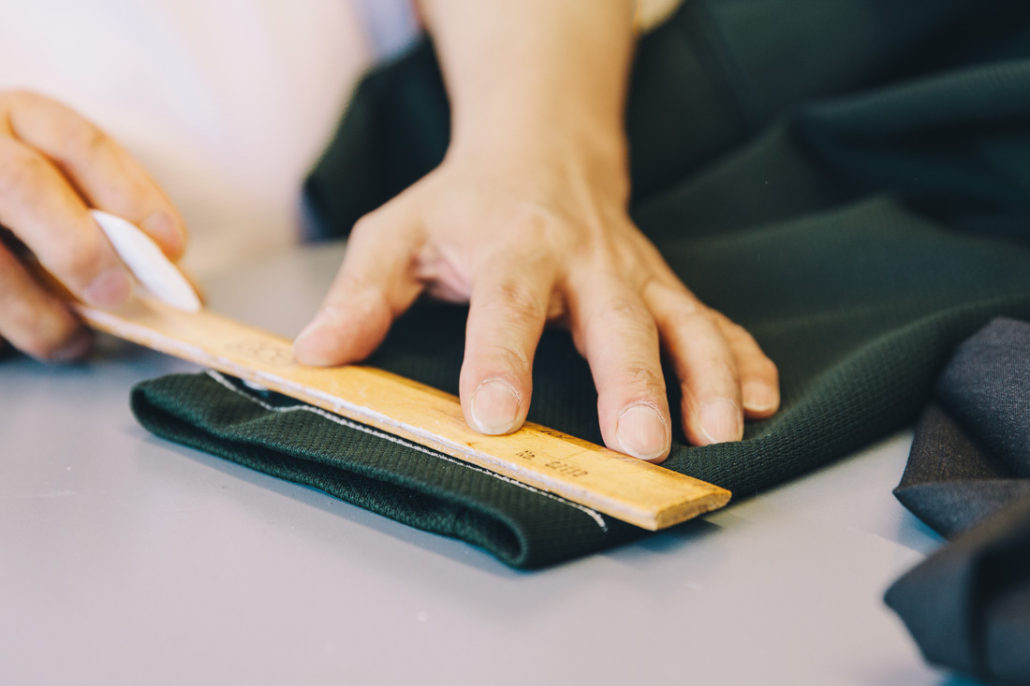


Комментариев нет:
Отправить комментарий